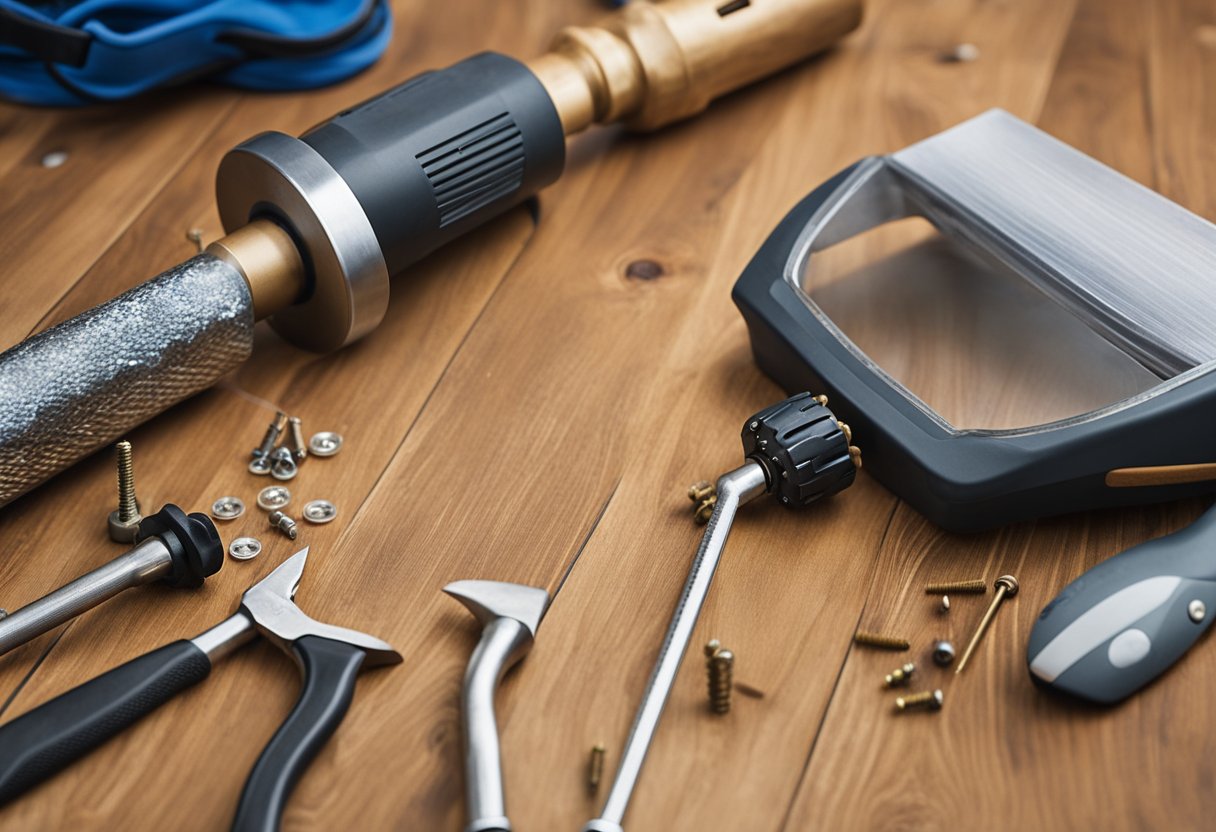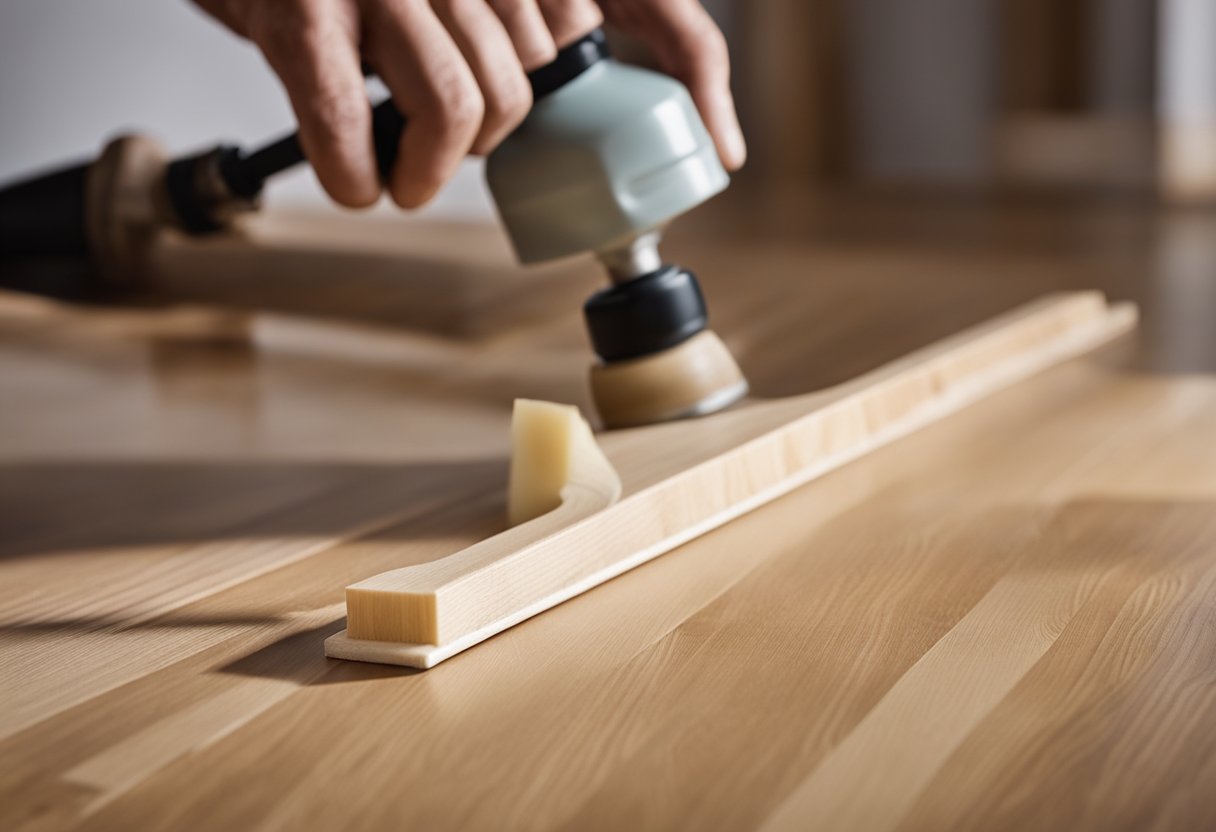Fixing squeaky laminate floors is a priority since the squeaky noise can be a nuisance, especially if you have just installed them.
This noise can be distracting and may even affect the quality of life in your home.

Understanding the root cause of laminate floor squeaks is the first step in fixing the issue. Sometimes, the problem may be related to the subfloor, while in other cases, it may be due to the laminate flooring itself.
Once you have identified the cause of the squeak, you can then proceed to fix it using the appropriate tools and techniques.
By following the steps outlined in this article, you can fix squeaky laminate floors and enjoy a quieter, more comfortable home.
From preparation steps to fixing techniques, this guide covers everything you need to know to address the issue. Whether you are a DIY enthusiast or prefer to hire a professional, this guide has got you covered.
Key Takeaways
- Understanding the root cause of laminate floor squeaks is crucial to fixing the issue.
- Proper preparation and the use of appropriate tools and techniques are essential to fixing squeaky laminate floors.
- Regular maintenance and preventative measures can help you avoid future issues with squeaky laminate floors.
Understanding Laminate Floor Squeaks

Laminate floors are a popular choice for homeowners due to their durability and affordability. However, one common problem with laminate floors is squeaking. Squeaks and creaks can be frustrating, but understanding the root causes can help homeowners find the best solution.
One reason for squeaky laminate floors is improper installation. If the flooring was not installed correctly, it can shift and move, causing squeaks. It is important to ensure that the subfloor is level and free of debris before installation.
Additionally, using the correct underlayment and following the manufacturer’s instructions can prevent squeaks.
Another cause of squeaky laminate floors is humidity. As humidity levels change, the laminate flooring can expand and contract, causing gaps between the planks. This movement can create a squeaking sound when pressure is applied to the floor.
Using a dehumidifier or air conditioner can help regulate humidity levels and prevent squeaks.
Wear and tear is another common cause of squeaky laminate floors. Over time, the locking system that holds the planks together can wear down, causing movement and noise.
Additionally, heavy foot traffic and furniture can cause the planks to shift and rub against each other, creating squeaks.
Regular maintenance, such as sweeping and vacuuming, can help prevent wear and tear and prolong the life of the flooring.
Tools and Materials Needed

Essential Tools
To fix squeaky laminate floors, a few essential tools are required.
These tools include a hammer, drill, screwdriver, pry bar, and a stud finder.
A hammer is used to hit the pry bar or the screwdriver to loosen the squeaky board.
A drill is used to make a hole in the squeaky board to insert the screw.
A screwdriver is used to tighten the screw, and a pry bar is used to remove the baseboard to access the subfloor.
Lastly, a stud finder is used to locate the joist to attach the screw.
Additional Materials
In addition to the essential tools, a few additional materials are also required.
These materials include wood screws, wood glue, shims, and a saw.
Wood screws are used to attach the squeaky board to the subfloor.
Wood glue is used to strengthen the bond between the subfloor and the squeaky board.
Shims are used to level the subfloor and to fill the gaps between the subfloor and the squeaky board.
Lastly, a saw is used to cut the shims to the required size.
Preparation Steps For Fixing Squeaky Laminate Floors

Before fixing squeaky laminate floors, there are some preparation steps that need to be taken to ensure the best results. This section outlines the necessary steps to take before beginning the repair process.
Floor Inspection
The first step in fixing squeaky laminate floors is to inspect the floor for any visible damage or deformities.
Check for any gaps or spaces between the planks or joints that may be causing the squeaking.
Inspect the subfloor for any damage or warping that may be contributing to the problem.
This will help to determine the best course of action for fixing the squeak.
Cleaning and Clearing the Area
Before starting any repair work, it is essential to clean and clear the area around the squeaky floorboards.
Remove any furniture or objects from the room to make it easier to work on the floor.
Sweep or vacuum the area to remove any debris or dirt that may interfere with the repair process.
This will also help to ensure that the repair work is done correctly and that the squeak does not return.
Fixing Techniques

Screw Fix Method
One of the most effective ways to fix a squeaky laminate floor is by using the screw fix method.
This method involves screwing the subfloor to the joist securely.
To do this, locate the squeaky area and drill a pilot hole through the laminate floor and subfloor.
Then, insert a screw through the hole and into the joist below. Repeat this process for all the squeaky areas.
This technique works well for floors that have a loose subfloor.
Lubrication Method
Another way to fix a squeaky laminate floor is by using a lubrication method.
This method involves applying a lubricant to the affected area.
For example, graphite powder can be used as a dry lubricant to reduce friction between the subfloor and laminate floor.
Simply sprinkle the powder onto the squeaky area and work it into the joints.
This technique is useful for floors that have a tight subfloor.
Floor Gap Solutions
Floor gaps can also cause squeaky laminate floors. To fix this issue, fill the gaps with a gap-filling adhesive.
This adhesive will fill the gaps and create a solid surface between the subfloor and laminate floor.
Another solution is to use a flooring repair kit.
These kits contain a putty-like substance that can be used to fill gaps and cracks in the laminate floor.
Once the gaps are filled, the squeaking should stop.
Addressing Subfloor Issues

Accessing the Subfloor
Before addressing squeaks in a laminate floor, it is important to access the subfloor.
To do so, remove the baseboard molding and floor covering.
Once the subfloor is exposed, examine it for any damage or loose areas that may be causing the squeaks.
Subfloor Repairs
If the subfloor is damaged, it must be repaired before addressing the squeaks.
To repair the subfloor, remove the damaged area and replace it with a new piece of plywood.
The new plywood should be the same thickness as the existing subfloor.
Once the new plywood is in place, secure it to the joists with screws, making sure to countersink the screws below the surface of the plywood.
If the subfloor is not damaged but is loose, it can be secured to the joists with screws.
To do so, locate the joists and mark their location on the subfloor.
Next, drill pilot holes through the subfloor and into the joists.
Finally, drive screws through the pilot holes and into the joists, making sure to countersink the screws below the surface of the subfloor.
Preventative Measures

Proper Installation
One of the most important steps in preventing squeaky laminate floors is ensuring proper installation.
This includes making sure the subfloor is clean, dry, and level before installing the laminate flooring.
It is also important to use the correct underlayment and to follow the manufacturer’s instructions for installation.
Proper installation will ensure that the laminate flooring is secure and will not shift or move, which can cause squeaks over time.
Humidity Control
Another important preventative measure to avoid squeaky laminate floors is controlling the humidity in the room.
Laminate flooring can expand and contract with changes in humidity, which can cause the planks to rub against each other and create squeaks.
To prevent this, it is important to maintain a consistent humidity level in the room.
This can be done by using a dehumidifier or humidifier, depending on the climate and time of year.
It is also important to avoid exposing the laminate flooring to excessive moisture, such as spills or leaks, which can cause warping and damage to the planks.
Professional Repair Options

If DIY methods don’t work, or if the homeowner is not comfortable with DIY repairs, there are professional repair options available.
A local flooring company can be hired to fix squeaky laminate floors. They have the necessary tools and expertise to diagnose the problem and fix it correctly.
The cost of professional repair depends on the extent of the damage and the location of the home. It is best to get multiple quotes from different companies to compare prices and services.
It is also important to check the company’s credentials and reviews before hiring them to ensure quality work.
Another option is to hire a handyman or contractor to fix the squeaky floors. However, it is generally recommended to hire a local flooring company for this repair as they specialize in flooring and have more experience with laminate floors.
Maintenance and Care

Regular Cleaning
To keep laminate floors in good condition, it is important to clean them regularly.
Sweeping or vacuuming with a soft brush attachment can help remove dirt and debris that can scratch the surface of the laminate. Wet mopping with a mild cleaner can also help remove dirt and grime.
Avoid using excess water, as this can cause the laminate to swell and warp.
Immediate Action on Spills
Spills should be cleaned up immediately to prevent damage to the laminate.
Use a soft cloth or paper towel to blot up the spill, then clean the area with a mild cleaner. Avoid using abrasive cleaners or scrubbers, as these can scratch the surface of the laminate.
Periodic Assessments
Periodically assessing the condition of the laminate floors can help detect any issues early on.
Check for any signs of damage or wear, such as scratches, chips, or cracks. If any issues are detected, they should be addressed promptly to prevent further damage.
Regular maintenance and care can help keep laminate floors looking their best for years to come. By following these simple steps, homeowners can enjoy beautiful, squeak-free floors that are both durable and easy to maintain.
Frequently Asked Questions on Fixing Squeaky Laminate Floors
What are the common causes of squeaky laminate floors?
Squeaky laminate floors are often caused by inadequate subfloor preparation, insufficient adhesive, or an uneven subfloor.
Other common causes include loose floorboards, improper installation, and humidity changes.
Can I fix a squeaky laminate floor without professional help?
Yes, it is possible to fix a squeaky laminate floor without professional help. However, it requires some basic DIY skills and tools.
What tools and materials are needed for repairing a squeaky laminate floor?
To repair a squeaky laminate floor, you will need a hammer, drill, screws, construction adhesive, wood glue, and a flooring repair kit.
Is it possible to silence squeaky floors under carpet without removing the carpet?
Yes, it is possible to silence squeaky floors under carpet without removing the carpet. The best way to fix squeaks under carpet is by using a squeak-reduction kit that includes special screws and brackets.
How does graphite powder help in fixing floor squeaks?
Graphite powder is a dry lubricant that can be used to reduce friction between the subfloor and the laminate flooring.
By sprinkling graphite powder along the seams of the laminate flooring, it can help reduce the noise caused by floor squeaks.
Are there any quick fixes for squeaky laminate floors that can be done in a day?
Yes, there are some quick fixes for squeaky laminate floors that can be done in a day. For example, you can try using baby powder or talcum powder to reduce the noise caused by floor squeaks. However, these quick fixes are not permanent solutions and may only provide temporary relief.